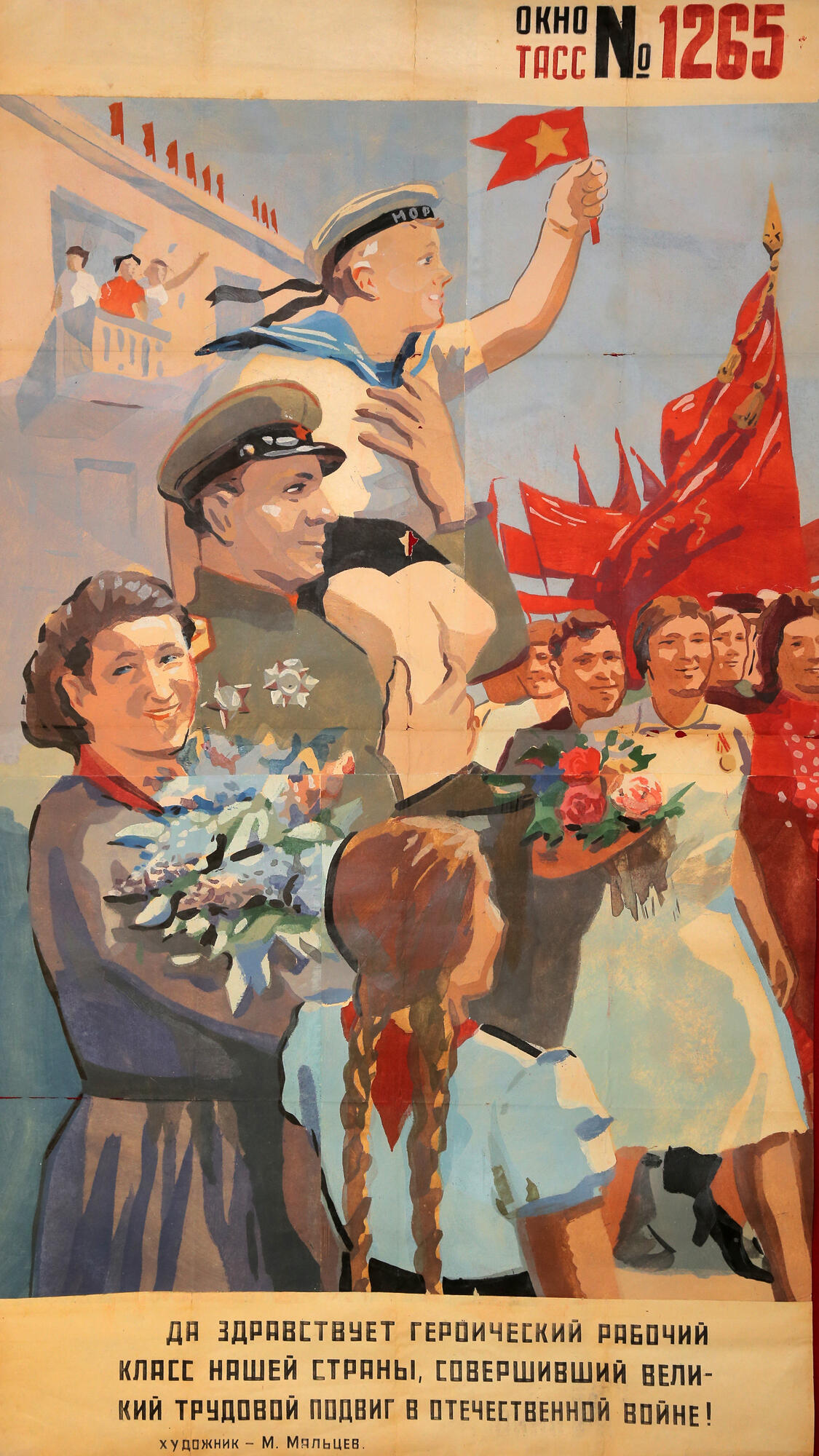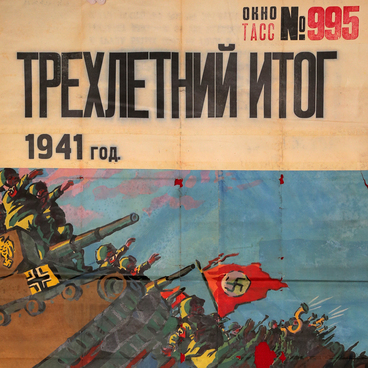‘TASS Windows’, an editorial workshop for the production of military-defense posters was created on June 25, 1941, on the third day of the Great Patriotic War. It was located in the premises of art salons on the Kuznetsky Most in Moscow. The first run of ‘TASS Windows’ consisted of eight original posters, it was released in the amount of 308 copies and pasted on the Moscow streets on June, 27.
The type of posters that the editorial office produced was called a limited edition. They were not created by printing, but by hand: special adhesive inks were applied to the paper using stencils. Compared to printed posters, ‘TASS Windows’ had more freedom in the choice of colors. Another feature was their mobility — the ability to respond quickly to events. The content of the posters was most often propaganda. Window No. 1265 ‘Long live the heroic working class, ’ which is kept in the museum’s collection, glorified the work of workers during the war.
During the Battle for Moscow in 1941-1942, the employees of “Windows” had to work in the most difficult conditions. Due to the lack of an oil solvent, the artists first switched to working with turpentine, and then with acetone. It was necessary to observe the conditions of blackout: the workshops of “Windows” were located next to the buildings of the Ministry of Foreign Affairs and the State Security Committee, so it was impossible to ventilate the premises at night. According to the recollections of workers, due to the high concentration of toxic fumes, the ambulance could take three to six stencil workers away in serious condition during the night.
The All-Union Society for Cultural Relations (ASCR) ordered duplicates of posters for foreign countries from “Windows.” The editors sent them to 20 countries around the world, including the United States, Great Britain, China, Sweden, and Latin American countries.
In 1942, several editorial staff members received the State Prize for their contribution to raising morale during the war. Poet Samuel Marshak, the Kukryniksy art group (Mikhail Kupriyanov, Porfiry Krylov, and Nikolai Sokolov), and artists Pavel Sokolov-Skalya, Georgy Savitsky, Nikolai Radlov, Peter Shukhmin, and Mikhail Cheremnykh were among the awardees. Printers and carvers of the editorial office were awarded the medal “For the Defense of Moscow.”
For several years of its existence, the TASS editorial office has manually released more than 15 million copies of military-defense posters.
The type of posters that the editorial office produced was called a limited edition. They were not created by printing, but by hand: special adhesive inks were applied to the paper using stencils. Compared to printed posters, ‘TASS Windows’ had more freedom in the choice of colors. Another feature was their mobility — the ability to respond quickly to events. The content of the posters was most often propaganda. Window No. 1265 ‘Long live the heroic working class, ’ which is kept in the museum’s collection, glorified the work of workers during the war.
During the Battle for Moscow in 1941-1942, the employees of “Windows” had to work in the most difficult conditions. Due to the lack of an oil solvent, the artists first switched to working with turpentine, and then with acetone. It was necessary to observe the conditions of blackout: the workshops of “Windows” were located next to the buildings of the Ministry of Foreign Affairs and the State Security Committee, so it was impossible to ventilate the premises at night. According to the recollections of workers, due to the high concentration of toxic fumes, the ambulance could take three to six stencil workers away in serious condition during the night.
The All-Union Society for Cultural Relations (ASCR) ordered duplicates of posters for foreign countries from “Windows.” The editors sent them to 20 countries around the world, including the United States, Great Britain, China, Sweden, and Latin American countries.
In 1942, several editorial staff members received the State Prize for their contribution to raising morale during the war. Poet Samuel Marshak, the Kukryniksy art group (Mikhail Kupriyanov, Porfiry Krylov, and Nikolai Sokolov), and artists Pavel Sokolov-Skalya, Georgy Savitsky, Nikolai Radlov, Peter Shukhmin, and Mikhail Cheremnykh were among the awardees. Printers and carvers of the editorial office were awarded the medal “For the Defense of Moscow.”
For several years of its existence, the TASS editorial office has manually released more than 15 million copies of military-defense posters.



